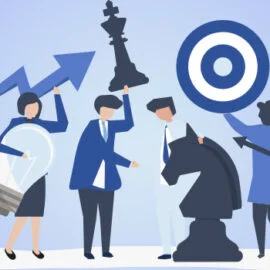
|
Getting your Trinity Audio player ready...
|
If you are a Small or Medium Business (SMB) owner, you are probably familiar with the challenges involved in acquiring customers and increasing sales. In this scenario, the sales funnel emerges as an essential strategic tool to boost the success of your business.
In this article, we will explore in depth the importance of the sales funnel for SMEs, how to implement it effectively and strategies to optimize it, step by step.
Introduction to the Sales Funnel
One sales funnel is a visual representation of the sales process, which helps to understand how customers move from initial interest to final purchase. Thus, for SMEs, this strategy is crucial, as it provides a clear and organized view of the path that their potential customers take until the purchase decision. In this way, it not only increases marketing efficiency but also drives sales in a structured way.
By understanding and optimizing each stage of the funnel, SMEs can target their efforts more precisely, focusing on specific areas that positively impact the conversion process. This increases the efficiency of the use of marketing resources, resulting in a more significant return on investment.
The sales funnel is divided into three main stages: top, middle, and bottom. At the top of the funnel, visitors are attracted to your website. When visitors reach the middle of the funnel, they become leads. At the bottom of the funnel, leads are converted into customers. We’ll take a closer look at each of these stages later.
How to Implement an Effective Sales Funnel
Identifying the target audience and the customer journey
Before implementing a sales funnel, it’s crucial to identify your target audience and understand their customer journey. Knowing your audience’s needs, challenges, and behaviors will allow you to tailor strategies for each stage of the funnel.
Creating relevant content for each stage of the funnel
Creating relevant content is key to attracting, converting, and closing deals. So tailor your content to meet the different needs and questions of leads at each stage, providing valuable information that will help them move through the funnel.
Using Marketing Automation Tools to Manage the Funnel
Automation tools, such as CRMs and email marketing platforms, can make managing your sales funnel easier. They help you track leads, personalize interactions, and automate processes, saving time and increasing efficiency.
Top of the sales funnel: attracting leads
Strategies to attract visitors to your website
Investing in content marketing strategies, such as blogs, videos and social networks, is essential to attract leads qualified. Therefore, use relevant keywords and maintain a consistent online presence to increase the visibility of your business.
How to create relevant content for your target audience
Develop educational and informative content that answers your target audience’s questions and needs. This not only attracts leads, but also establishes your company as an authority in the industry.
Using SEO techniques to increase your website's visibility
Optimizing your website for search engines is essential to ensuring that your website is found by potential leads. So research relevant keywords, optimize meta descriptions, and create quality content that will attract the attention of search engines.
Middle of the Sales Funnel: Converting Leads into Customers
How to nurture and qualify leads to increase conversion chances
Offer more detailed, personalized content to leads who have shown interest. Then, use emails, webinars, and rich materials to nurture leads and prepare them for the conversion stage.
Strategies to create a sense of urgency and encourage customer action
Introduce limited-time promotions, exclusive discounts, or special offers to create a sense of urgency. This encourages leads to take action and move to the next stage of the funnel. Work with mental triggers to increase conversion rates.
Using remarketing techniques to recover lost leads
The remarketing is a powerful strategy for re-engaging leads who visited your website but didn’t convert. Show them personalized ads to remind them of the value your business offers.
Middle of the sales funnel: education and engagement
How to educate leads about the products or services offered
Provide detailed information about your products or services, highlighting benefits and differentiators. Use tutorials, case studies, and educational content to clarify doubts and build trust.
Tools and resources to maintain engagement
Incorporate chatbots, personalized emails, and social media interactions to maintain engagement. Respond promptly to leads’ questions to demonstrate commitment and care. As a result, engagement will increase and lead retention will increase.
Importance of providing relevant information for decision making
Leads are more likely to convert when they have all the information they need. Make sure you provide relevant content that helps them make informed and comfortable decisions.
Bottom of the sales funnel: closing
Strategies to drive qualified leads to the decision stage
Personalize your sales pitch based on your leads’ behavior and preferences. Show them how your product or service solves their specific problems.
Use of calls-to-action (CTAs) persuasive
Integrate persuasive CTAs into your marketing materials and website. Use compelling language that encourages leads to take the desired action, whether that’s making a purchase, scheduling a demo, or getting in touch.
Importance of proactive follow-up to close deals
Proactive follow-up is crucial to closing deals, so be prepared to answer questions, provide additional information, and offer ongoing support to ensure a smooth transition from lead to customer.
Optimizing the sales funnel
How to evaluate sales funnel performance
Use metrics like conversion rates, sales cycle time, and customer value to assess funnel performance. Then, analyze the data regularly to identify areas for improvement.
Tools and metrics to measure funnel success
Implement analytical tools such as Google Analytics and marketing automation platforms to measure the success of the funnel. And track specific metrics to understand the impact of each stage.
Tips for optimizing your sales funnel and increasing conversions
Be open to adjusting your strategy based on the data you collect. So test different approaches, adjust content as needed, and be on the lookout for opportunities for continuous improvement.
In short…
The sales funnel is a crucial piece of the marketing puzzle for SMBs. By understanding its stages, implementing effective strategies, and constantly optimizing performance, SMBs can create an efficient, data-driven sales machine.
If you haven’t implemented a sales funnel for your SMB yet, now is the perfect time to start. So, identify your target audience, create relevant content, and use automation tools to enhance your approach. By doing so, you’ll be on your way to increasing sales, winning loyal customers, and driving sustainable growth for your business. Remember, a sales funnel is more than just a strategy; it’s the key to your SMB’s long-term success in the digital marketing world.
Image: Freepik

Marcel Castilho is a specialist in digital marketing, neuromarketing, neuroscience, mindfulness and positive psychology. In addition to being an advertiser, he also has a Master's degree in Neurolinguistic Programming. He is the founder and owner of Vero Comunicação and also the digital agency Vero Contents.




